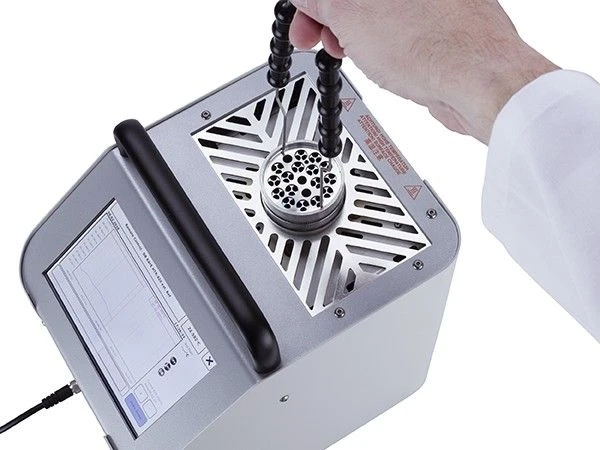Accurate temperature measurement is critical across many industries including pharmaceuticals, manufacturing, food processing, and environmental monitoring. To maintain precision and reliability, temperature sensors must be calibrated regularly against a trusted standard. One of the most popular and versatile tools for this purpose is the Temperature Dry Block Calibrator. This device offers a practical, portable, and efficient way to verify and calibrate temperature sensors, thermometers, and probes.
What is a Temperature Dry Block Calibrator?
A Temperature Dry Block Calibrator is a temperature calibration instrument designed to provide a stable and uniform temperature environment for testing and calibrating temperature sensors. It features a solid metal block—often made of aluminum or other high-conductivity alloys—with multiple holes or wells drilled into it. These wells are sized to fit various sensor probes, such as thermocouples, resistance temperature detectors (RTDs), and digital thermometers.
The block is heated or cooled electronically to a specific temperature setpoint, creating a controlled thermal environment that mimics real-world conditions. Users insert the sensors into the wells to compare their readings against the calibrator’s known temperature, enabling accurate calibration.
Advantages of Using a Temperature Dry Block Calibrator
- Portability and Convenience: Unlike liquid bath calibrators, which require fluids and are bulky, dry block calibrators are compact and easy to transport. This makes them ideal for on-site calibration tasks where lab conditions are not available.
- Clean and Safe Operation: Because no liquids are involved, dry block calibrators eliminate the risks of spills, burns, and contamination. This feature makes them particularly useful in cleanroom environments or industries with strict hygiene requirements.
- Wide Temperature Range: Temperature dry block calibrators typically cover a broad temperature range—from sub-zero (with optional cooling attachments) up to 700°C or more, depending on the model. This versatility allows calibration of sensors used in diverse applications.
- Fast Stabilization Time: Dry block calibrators generally reach target temperatures faster than liquid baths, reducing calibration time and improving efficiency.
- Low Maintenance: Without fluids to replace or dispose of, dry block calibrators require minimal upkeep, lowering operating costs.
How Does a Temperature Dry Block Calibrator Work?
The heart of the dry block calibrator is its heating and control system. The metal block contains embedded heating elements and temperature sensors that monitor and regulate the block’s temperature with high precision. The user selects the desired temperature setpoint on the device’s controller interface. The heating elements raise the block temperature, which is continuously monitored by internal sensors to maintain stability within a narrow tolerance, often as precise as ±0.01°C.
The sensor probes are inserted into the corresponding wells, ensuring close thermal contact with the block. Because the block is solid metal, heat transfer is efficient, allowing the sensor to quickly equilibrate to the block temperature. Calibration technicians then compare the sensor reading with the dry block’s set temperature and apply any necessary adjustments or document the sensor’s accuracy.
Applications of Temperature Dry Block Calibrators
Temperature dry block calibrator are used in a wide array of industries:
- Pharmaceuticals: Calibrating sensors that monitor temperature during drug production and storage, ensuring product efficacy and safety.
- Food Industry: Verifying temperature sensors used in cooking, refrigeration, and storage to comply with health regulations.
- Manufacturing: Ensuring precision temperature control in processes such as metal treatment, plastics molding, and electronics manufacturing.
- HVAC and Building Management: Testing and calibrating temperature sensors in heating, ventilation, and air conditioning systems.
- Research and Development: Providing a reliable temperature source for sensor development and experimental validation.
Choosing the Right Temperature Dry Block Calibrator
When selecting a dry block calibrator, consider the following factors:
- Temperature Range: Ensure the device covers the temperature span needed for your specific sensors.
- Number and Size of Wells: Match the well sizes and quantity to your sensor probes for efficient calibration.
- Accuracy and Stability: Look for models with tight temperature stability and precision to ensure reliable calibration results.
- Portability and Power Options: Battery-powered or lightweight models offer greater flexibility for field use.
- Additional Features: Some calibrators include data logging, programmable temperature profiles, or wireless connectivity for enhanced usability.
Conclusion
A Temperature Dry Block Calibrator is an indispensable tool for maintaining accurate temperature measurement and sensor performance. Its portability, safety, wide temperature range, and ease of use make it a preferred choice for on-site and laboratory calibrations alike. Investing in a high-quality dry block calibrator ensures your temperature sensors remain precise, helping you maintain product quality, regulatory compliance, and operational efficiency across industries.


